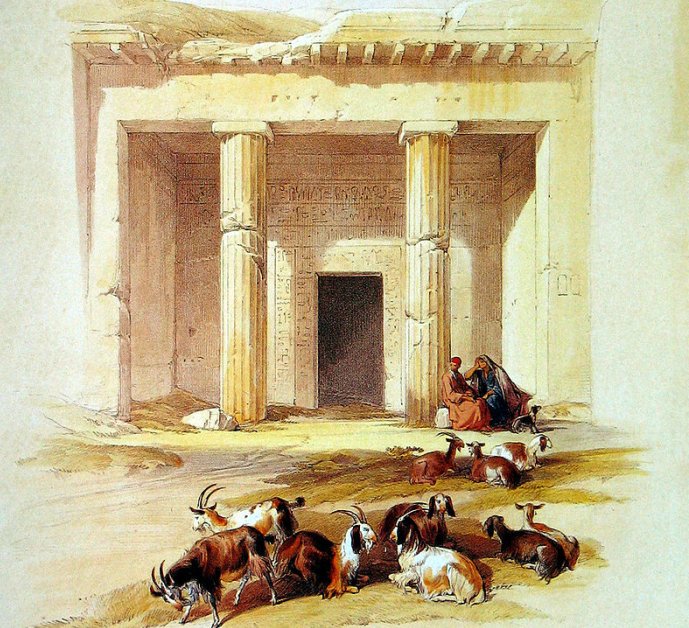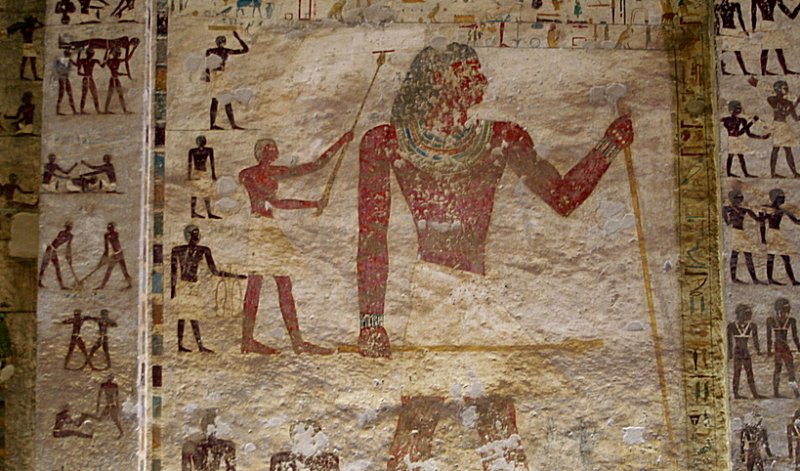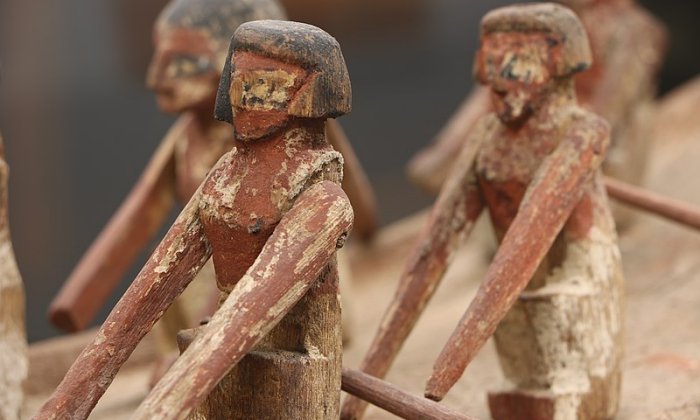Rock-Cut Tombs Of Beni Hasan With Spells, Prayers To Osiris And Anubis And Map To Underworld
A. Sutherland - AncientPages.com - The rock-cut tombs of an ancient Egyptian cemetery, Beni Hasan, were mainly used during the Middle Kingdom, from 21st to 17th century BC.
Entrance to a Tomb at Beni Hassan, David Roberts, 1838. Image credit: David Roberts - Public domain
They were constructed for many powerful nobles and provincial governors of the 11th and 12th dynasties (2125-1795 BC). During the reign of Sesostris III, many local workers decorated them, but later, when Sesostris III's power was reduced mainly, this burial tradition ceased.
There are 39 tombs carved into the limestone hillside south of the modern town of Minya on the east side of the Nile in Middle Egypt. Many have rich interior paintings depicting scenes from everyday life: most of them were robbed many times in antiquity.
However, the well-preserved wall decoration remained untouched until Percy Newberry, British Egyptologist, began meticulously recording every scene on the walls in 1890.
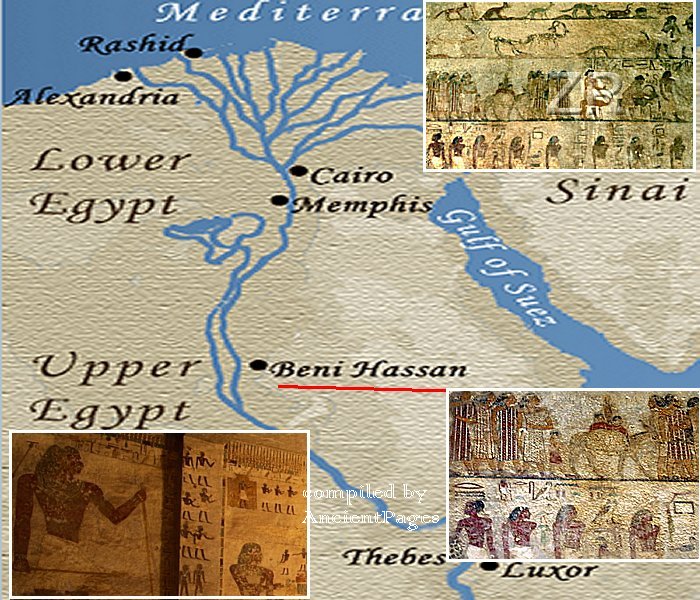 The tombs were constructed for many powerful nobles and provincial governors of the 11th and 12th dynasties (2125-1795 BC).
The tombs were constructed for many powerful nobles and provincial governors of the 11th and 12th dynasties (2125-1795 BC).
Ten years later, English archaeologist, John Garstang (1876 - 1956), came to Beni Hasan. During his two-year-long work, he unearthed and investigated almost nine hundred vertically-cut shaft tombs belonging to ordinary people who served the nobles.
Of all 39, only four of the tombs (those of Baqet III, Khety, Khnumhotep III, and Amenemhat) are available for visitors. The most impressive of them is that of Khnumhotep III, with a scene depicting the arrival of Asian visitors to Egypt.
Representation of Khety in his tomb (tomb 17). Image credit: Kurohito - CC BY-SA 3.0
The tombs have columned entrances and the walls painted in horizontal registers that run around them. There are scenes with the provision of food, gathering papyrus, fishing and hunting, spinning and weaving, but simple local workers and not artists made the decorations. The figures have long, stick-like limbs that are disproportionate in size, all painted in grey, pink and orange colors.
The ownership of the tombs was recorded on the painted wooden coffins, which contained several burials, perhaps the entire families). The coffins were inscribed with a prayer to Anubis or Osiris and decorated with a pair of eyes. Through the eyes, the deceased could see.
Spells painted on the coffins' inside guaranteed the deceased's passage to the afterlife, and a 'map' to the underworld on the coffin's floor guided the soul on its journey.
Beni Hasan model funerary boat with crew. Image credit: Voluremuseum - CC BY-SA 4.0
Many of the bodies were badly mummified and wrapped quickly in bandages. No investigation confirmed whether the bodies were buried at the same time or added in different periods.
The most curious feature of the tombs was the colorfully painted tiny, wooden models found in every chamber and depicting miniature figures working in granaries, bakeries, different shops, workshops of carpenters, goldsmiths, and other artisans and industries.
Archaeologists also discovered model boats with tiny figurines of wooden sailors and miniature human figures (no more than 15cm (6in) tall and about 7.5cm (3in) in the tombs of the governors. They symbolized 'continuously work' for the deceased in the afterlife.
The most beautiful is the grave of Khnumhotep III, an Ancient Egyptian high steward and vizier of the 12th Dynasty. The tomb's walls are covered with lively and colorful scenes with many themes and Khnumhotep's well-preserved biographical inscription.
Written by – A. Sutherland AncientPages.com Staff Writer
Updated on August 2, 2022
Copyright © AncientPages.com All rights reserved. This material may not be published, broadcast, rewritten or redistributed in whole or part without the express written permission of AncientPages.com
Expand for referencesReferences:
I. Rosellini, F.Serino, The Monuments of Egypt and Nubia
Hobson Ch. Exploring the World of the Pharaohs
Spara
Spara
Spara
Spara
Spara
More From Ancient Pages
-
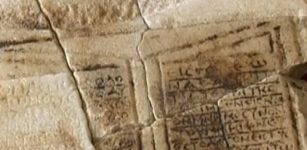 Last Fragment Of Early Christian Christogram Found In Ancient City Of Parthicopolis, Bulgaria
Artifacts | Sep 9, 2015
Last Fragment Of Early Christian Christogram Found In Ancient City Of Parthicopolis, Bulgaria
Artifacts | Sep 9, 2015 -
 Unknown Fragments Of Two Euripides Tragedies Found In Egyptian Grave
Scripts, Paintings & Inscriptions | Sep 9, 2024
Unknown Fragments Of Two Euripides Tragedies Found In Egyptian Grave
Scripts, Paintings & Inscriptions | Sep 9, 2024 -
 Scientists Investigate – Did The Human Brain Shrink 3,000 Years Ago?
Human Beginnings | Aug 6, 2022
Scientists Investigate – Did The Human Brain Shrink 3,000 Years Ago?
Human Beginnings | Aug 6, 2022 -
 William Marshal Earl Of Pembroke: Master Of Tournaments And Best Example Of Medieval Chivalry And Knighthood
Featured Stories | Jul 7, 2017
William Marshal Earl Of Pembroke: Master Of Tournaments And Best Example Of Medieval Chivalry And Knighthood
Featured Stories | Jul 7, 2017 -
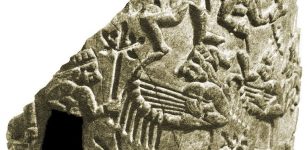 Lugal-Anne-Mundu: ‘King Of The Universe’ And Powerful Leader Who Restored Sumer To Its Former Glory
Civilizations | Oct 1, 2016
Lugal-Anne-Mundu: ‘King Of The Universe’ And Powerful Leader Who Restored Sumer To Its Former Glory
Civilizations | Oct 1, 2016 -
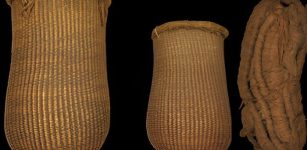 9,500-Year-Old Baskets And 6,200-Year-Old Sandals Found In Spanish Cave
Archaeology | Sep 28, 2023
9,500-Year-Old Baskets And 6,200-Year-Old Sandals Found In Spanish Cave
Archaeology | Sep 28, 2023 -
 Fenrir: Oldest Of Three Monstrous Children Of God Loki In Norse Mythology
Featured Stories | Mar 28, 2018
Fenrir: Oldest Of Three Monstrous Children Of God Loki In Norse Mythology
Featured Stories | Mar 28, 2018 -
 A 500-Year-Old Stolen Copy Of da Vinci’s “Salvator Mundi” Painting – Found By Italian Police
News | Jan 20, 2021
A 500-Year-Old Stolen Copy Of da Vinci’s “Salvator Mundi” Painting – Found By Italian Police
News | Jan 20, 2021 -
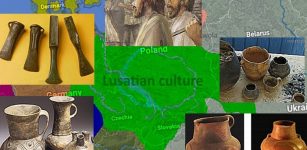 Lusatian Culture: Ancient Traders Of Central Europe Built Strongly Fortified Settlements To Withstand Scythian Attacks
Civilizations | Jan 27, 2024
Lusatian Culture: Ancient Traders Of Central Europe Built Strongly Fortified Settlements To Withstand Scythian Attacks
Civilizations | Jan 27, 2024 -
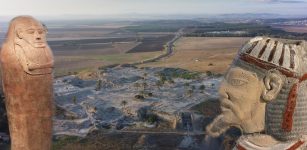 Ancient Mystery Of The Biblical Canaanites – New DNA Insight
Archaeology | May 28, 2020
Ancient Mystery Of The Biblical Canaanites – New DNA Insight
Archaeology | May 28, 2020 -
 Trentren And Caicai: The Battling Serpents Of Chilote Mythology
Featured Stories | Jul 10, 2022
Trentren And Caicai: The Battling Serpents Of Chilote Mythology
Featured Stories | Jul 10, 2022 -
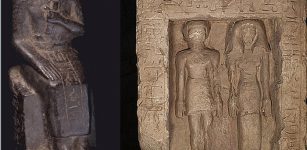 Excavation At Tell Edfu Reveals Early New Kingdom Complex
Archaeology | Jan 10, 2019
Excavation At Tell Edfu Reveals Early New Kingdom Complex
Archaeology | Jan 10, 2019 -
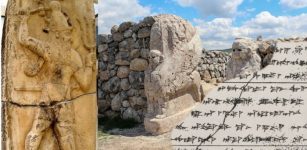 3,500-Year-Old Cuneiform Clay Tablets With Hittites’ Texts – Soon To Be Accessible Online
News | Oct 15, 2020
3,500-Year-Old Cuneiform Clay Tablets With Hittites’ Texts – Soon To Be Accessible Online
News | Oct 15, 2020 -
 Magnetic Survey Finds Huge Previously Unknown Ancient Buildings In Abandoned Assyrian Capital Khorsabad
Archaeology | Dec 20, 2024
Magnetic Survey Finds Huge Previously Unknown Ancient Buildings In Abandoned Assyrian Capital Khorsabad
Archaeology | Dec 20, 2024 -
 Pre-Inca Temple With Colored Paintings And Carved Sculptures Discovered At The Los Paredones Archaeological Complex, Peru
Archaeology | Jul 8, 2024
Pre-Inca Temple With Colored Paintings And Carved Sculptures Discovered At The Los Paredones Archaeological Complex, Peru
Archaeology | Jul 8, 2024 -
 When And What Was The Golden Age Of Piracy?
Ancient History Facts | Jul 25, 2016
When And What Was The Golden Age Of Piracy?
Ancient History Facts | Jul 25, 2016 -
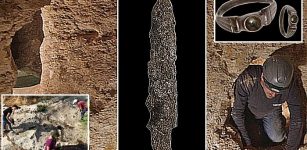 Hiding Tunnel Complex Dated To The Bar Kokhba Revolt Revealed Near The Sea of Galilee
Archaeology | Apr 23, 2024
Hiding Tunnel Complex Dated To The Bar Kokhba Revolt Revealed Near The Sea of Galilee
Archaeology | Apr 23, 2024 -
 Archaeologists Begin Excavations Of A Sunken Zhiyuan Warship That Sank In 1894
Archaeology | Oct 7, 2015
Archaeologists Begin Excavations Of A Sunken Zhiyuan Warship That Sank In 1894
Archaeology | Oct 7, 2015 -
 Remains of Maurya-Era Wall Discovered In Tilaurakot, Kapilvastu, Nepal
Archaeology | Jun 16, 2022
Remains of Maurya-Era Wall Discovered In Tilaurakot, Kapilvastu, Nepal
Archaeology | Jun 16, 2022 -
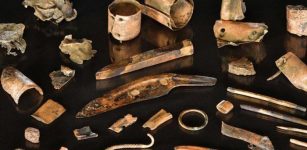 Unique Belongings Of Bronze Age Warrior Offer Evidence Of Massive Violent Conflict In Europe
Archaeology | Oct 18, 2019
Unique Belongings Of Bronze Age Warrior Offer Evidence Of Massive Violent Conflict In Europe
Archaeology | Oct 18, 2019

